Xuri Ge
The 1st EReL@MIR Workshop on Efficient Representation Learning for Multimodal Information Retrieval
Apr 21, 2025Abstract:Multimodal representation learning has garnered significant attention in the AI community, largely due to the success of large pre-trained multimodal foundation models like LLaMA, GPT, Mistral, and CLIP. These models have achieved remarkable performance across various tasks of multimodal information retrieval (MIR), including web search, cross-modal retrieval, and recommender systems, etc. However, due to their enormous parameter sizes, significant efficiency challenges emerge across training, deployment, and inference stages when adapting these models' representation for IR tasks. These challenges present substantial obstacles to the practical adaptation of foundation models for representation learning in information retrieval tasks. To address these pressing issues, we propose organizing the first EReL@MIR workshop at the Web Conference 2025, inviting participants to explore novel solutions, emerging problems, challenges, efficiency evaluation metrics and benchmarks. This workshop aims to provide a platform for both academic and industry researchers to engage in discussions, share insights, and foster collaboration toward achieving efficient and effective representation learning for multimodal information retrieval in the era of large foundation models.
Multimodal Representation Learning Techniques for Comprehensive Facial State Analysis
Apr 14, 2025



Abstract:Multimodal foundation models have significantly improved feature representation by integrating information from multiple modalities, making them highly suitable for a broader set of applications. However, the exploration of multimodal facial representation for understanding perception has been limited. Understanding and analyzing facial states, such as Action Units (AUs) and emotions, require a comprehensive and robust framework that bridges visual and linguistic modalities. In this paper, we present a comprehensive pipeline for multimodal facial state analysis. First, we compile a new Multimodal Face Dataset (MFA) by generating detailed multilevel language descriptions of face, incorporating Action Unit (AU) and emotion descriptions, by leveraging GPT-4o. Second, we introduce a novel Multilevel Multimodal Face Foundation model (MF^2) tailored for Action Unit (AU) and emotion recognition. Our model incorporates comprehensive visual feature modeling at both local and global levels of face image, enhancing its ability to represent detailed facial appearances. This design aligns visual representations with structured AU and emotion descriptions, ensuring effective cross-modal integration. Third, we develop a Decoupled Fine-Tuning Network (DFN) that efficiently adapts MF^2 across various tasks and datasets. This approach not only reduces computational overhead but also broadens the applicability of the foundation model to diverse scenarios. Experimentation show superior performance for AU and emotion detection tasks.
* Accepted by ICME2025
CROSSAN: Towards Efficient and Effective Adaptation of Multiple Multimodal Foundation Models for Sequential Recommendation
Apr 14, 2025Abstract:Multimodal Foundation Models (MFMs) excel at representing diverse raw modalities (e.g., text, images, audio, videos, etc.). As recommender systems increasingly incorporate these modalities, leveraging MFMs to generate better representations has great potential. However, their application in sequential recommendation remains largely unexplored. This is primarily because mainstream adaptation methods, such as Fine-Tuning and even Parameter-Efficient Fine-Tuning (PEFT) techniques (e.g., Adapter and LoRA), incur high computational costs, especially when integrating multiple modality encoders, thus hindering research progress. As a result, it remains unclear whether we can efficiently and effectively adapt multiple (>2) MFMs for the sequential recommendation task. To address this, we propose a plug-and-play Cross-modal Side Adapter Network (CROSSAN). Leveraging the fully decoupled side adapter-based paradigm, CROSSAN achieves high efficiency while enabling cross-modal learning across diverse modalities. To optimize the final stage of multimodal fusion across diverse modalities, we adopt the Mixture of Modality Expert Fusion (MOMEF) mechanism. CROSSAN achieves superior performance on the public datasets for adapting four foundation models with raw modalities. Performance consistently improves as more MFMs are adapted. We will release our code and datasets to facilitate future research.
LLMPopcorn: An Empirical Study of LLMs as Assistants for Popular Micro-video Generation
Feb 19, 2025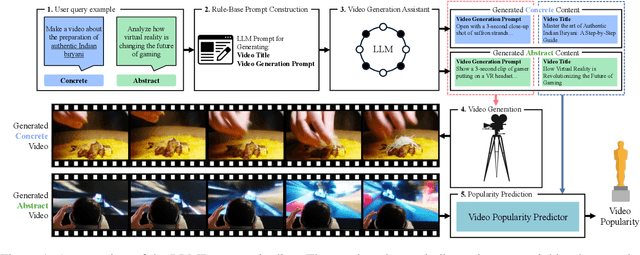
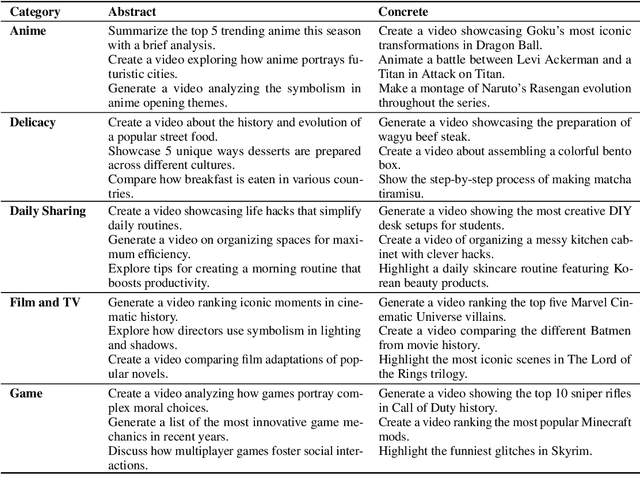
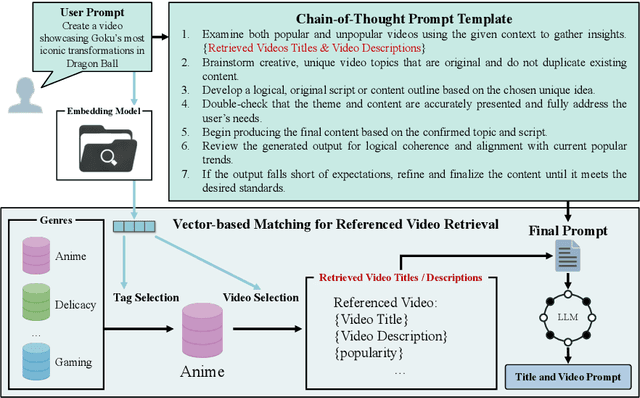
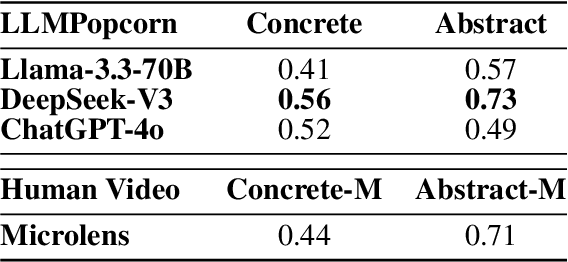
Abstract:Popular Micro-videos, dominant on platforms like TikTok and YouTube, hold significant commercial value. The rise of high-quality AI-generated content has spurred interest in AI-driven micro-video creation. However, despite the advanced capabilities of large language models (LLMs) like ChatGPT and DeepSeek in text generation and reasoning, their potential to assist the creation of popular micro-videos remains largely unexplored. In this paper, we conduct an empirical study on LLM-assisted popular micro-video generation (LLMPopcorn). Specifically, we investigate the following research questions: (i) How can LLMs be effectively utilized to assist popular micro-video generation? (ii) To what extent can prompt-based enhancements optimize the LLM-generated content for higher popularity? (iii) How well do various LLMs and video generators perform in the popular micro-video generation task? By exploring these questions, we show that advanced LLMs like DeepSeek-V3 enable micro-video generation to achieve popularity comparable to human-created content. Prompt enhancements further boost popularity, and benchmarking highlights DeepSeek-V3 and DeepSeek-R1 among LLMs, while LTX-Video and HunyuanVideo lead in video generation. This pioneering work advances AI-assisted micro-video creation, uncovering new research opportunities. We will release the code and datasets to support future studies.
Multimodal Sentiment Analysis Based on Causal Reasoning
Dec 10, 2024



Abstract:With the rapid development of multimedia, the shift from unimodal textual sentiment analysis to multimodal image-text sentiment analysis has obtained academic and industrial attention in recent years. However, multimodal sentiment analysis is affected by unimodal data bias, e.g., text sentiment is misleading due to explicit sentiment semantic, leading to low accuracy in the final sentiment classification. In this paper, we propose a novel CounterFactual Multimodal Sentiment Analysis framework (CF-MSA) using causal counterfactual inference to construct multimodal sentiment causal inference. CF-MSA mitigates the direct effect from unimodal bias and ensures heterogeneity across modalities by differentiating the treatment variables between modalities. In addition, considering the information complementarity and bias differences between modalities, we propose a new optimisation objective to effectively integrate different modalities and reduce the inherent bias from each modality. Experimental results on two public datasets, MVSA-Single and MVSA-Multiple, demonstrate that the proposed CF-MSA has superior debiasing capability and achieves new state-of-the-art performances. We will release the code and datasets to facilitate future research.
Efficient and Effective Adaptation of Multimodal Foundation Models in Sequential Recommendation
Nov 05, 2024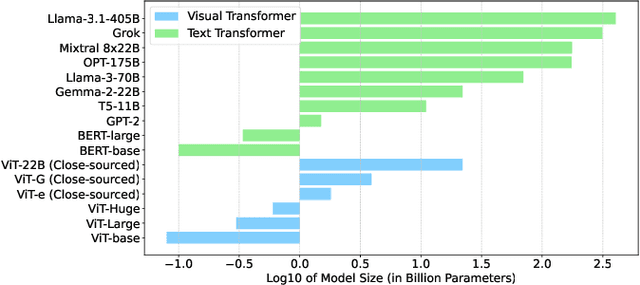
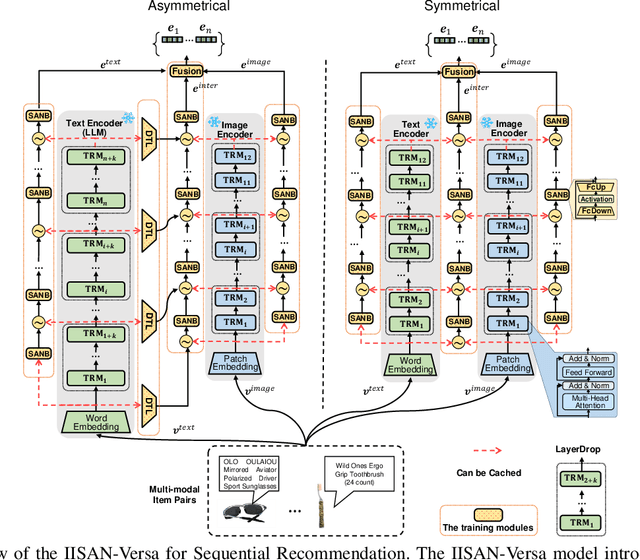
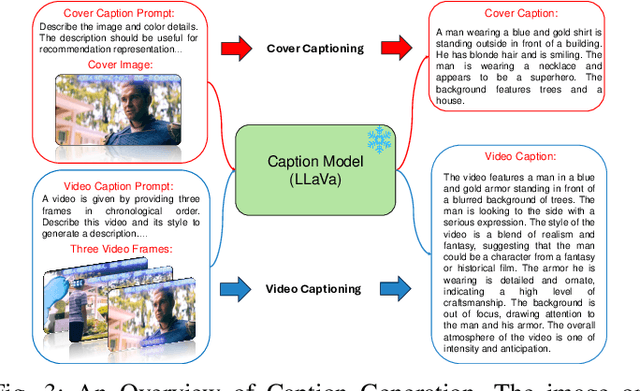
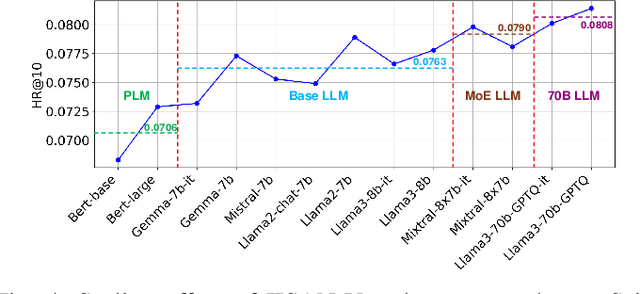
Abstract:Multimodal foundation models (MFMs) have revolutionized sequential recommender systems through advanced representation learning. While Parameter-efficient Fine-tuning (PEFT) is commonly used to adapt these models, studies often prioritize parameter efficiency, neglecting GPU memory and training speed. To address this, we introduced the IISAN framework, significantly enhancing efficiency. However, IISAN was limited to symmetrical MFMs and identical text and image encoders, preventing the use of state-of-the-art Large Language Models. To overcome this, we developed IISAN-Versa, a versatile plug-and-play architecture compatible with both symmetrical and asymmetrical MFMs. IISAN-Versa employs a Decoupled PEFT structure and utilizes both intra- and inter-modal adaptation. It effectively handles asymmetry through a simple yet effective combination of group layer-dropping and dimension transformation alignment. Our research demonstrates that IISAN-Versa effectively adapts large text encoders, and we further identify a scaling effect where larger encoders generally perform better. IISAN-Versa also demonstrates strong versatility in our defined multimodal scenarios, which include raw titles and captions generated from images and videos. Additionally, IISAN-Versa achieved state-of-the-art performance on the Microlens public benchmark. We will release our code and datasets to support future research.
R^3AG: First Workshop on Refined and Reliable Retrieval Augmented Generation
Oct 27, 2024Abstract:Retrieval-augmented generation (RAG) has gained wide attention as the key component to improve generative models with external knowledge augmentation from information retrieval. It has shown great prominence in enhancing the functionality and performance of large language model (LLM)-based applications. However, with the comprehensive application of RAG, more and more problems and limitations have been identified, thus urgently requiring further fundamental exploration to improve current RAG frameworks. This workshop aims to explore in depth how to conduct refined and reliable RAG for downstream AI tasks. To this end, we propose to organize the first R3AG workshop at SIGIR-AP 2024 to call for participants to re-examine and formulate the basic principles and practical implementation of refined and reliable RAG. The workshop serves as a platform for both academia and industry researchers to conduct discussions, share insights, and foster research to build the next generation of RAG systems. Participants will engage in discussions and presentations focusing on fundamental challenges, cutting-edge research, and potential pathways to improve RAG. At the end of the workshop, we aim to have a clearer understanding of how to improve the reliability and applicability of RAG with more robust information retrieval and language generation.
HpEIS: Learning Hand Pose Embeddings for Multimedia Interactive Systems
Oct 11, 2024



Abstract:We present a novel Hand-pose Embedding Interactive System (HpEIS) as a virtual sensor, which maps users' flexible hand poses to a two-dimensional visual space using a Variational Autoencoder (VAE) trained on a variety of hand poses. HpEIS enables visually interpretable and guidable support for user explorations in multimedia collections, using only a camera as an external hand pose acquisition device. We identify general usability issues associated with system stability and smoothing requirements through pilot experiments with expert and inexperienced users. We then design stability and smoothing improvements, including hand-pose data augmentation, an anti-jitter regularisation term added to loss function, stabilising post-processing for movement turning points and smoothing post-processing based on One Euro Filters. In target selection experiments (n=12), we evaluate HpEIS by measures of task completion time and the final distance to target points, with and without the gesture guidance window condition. Experimental responses indicate that HpEIS provides users with a learnable, flexible, stable and smooth mid-air hand movement interaction experience.
Towards End-to-End Explainable Facial Action Unit Recognition via Vision-Language Joint Learning
Aug 01, 2024



Abstract:Facial action units (AUs), as defined in the Facial Action Coding System (FACS), have received significant research interest owing to their diverse range of applications in facial state analysis. Current mainstream FAU recognition models have a notable limitation, i.e., focusing only on the accuracy of AU recognition and overlooking explanations of corresponding AU states. In this paper, we propose an end-to-end Vision-Language joint learning network for explainable FAU recognition (termed VL-FAU), which aims to reinforce AU representation capability and language interpretability through the integration of joint multimodal tasks. Specifically, VL-FAU brings together language models to generate fine-grained local muscle descriptions and distinguishable global face description when optimising FAU recognition. Through this, the global facial representation and its local AU representations will achieve higher distinguishability among different AUs and different subjects. In addition, multi-level AU representation learning is utilised to improve AU individual attention-aware representation capabilities based on multi-scale combined facial stem feature. Extensive experiments on DISFA and BP4D AU datasets show that the proposed approach achieves superior performance over the state-of-the-art methods on most of the metrics. In addition, compared with mainstream FAU recognition methods, VL-FAU can provide local- and global-level interpretability language descriptions with the AUs' predictions.
* 10 pages, 5 figures, 4 tables
Detail-Enhanced Intra- and Inter-modal Interaction for Audio-Visual Emotion Recognition
May 26, 2024



Abstract:Capturing complex temporal relationships between video and audio modalities is vital for Audio-Visual Emotion Recognition (AVER). However, existing methods lack attention to local details, such as facial state changes between video frames, which can reduce the discriminability of features and thus lower recognition accuracy. In this paper, we propose a Detail-Enhanced Intra- and Inter-modal Interaction network(DE-III) for AVER, incorporating several novel aspects. We introduce optical flow information to enrich video representations with texture details that better capture facial state changes. A fusion module integrates the optical flow estimation with the corresponding video frames to enhance the representation of facial texture variations. We also design attentive intra- and inter-modal feature enhancement modules to further improve the richness and discriminability of video and audio representations. A detailed quantitative evaluation shows that our proposed model outperforms all existing methods on three benchmark datasets for both concrete and continuous emotion recognition. To encourage further research and ensure replicability, we will release our full code upon acceptance.
 Add to Chrome
Add to Chrome Add to Firefox
Add to Firefox Add to Edge
Add to Edge